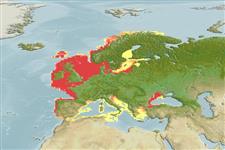>
Gobiiformes (Gobies) >
Gobiidae (Gobies) > Gobionellinae
Etymology: Pomatoschistus: Greek, poma, -atos = cover, operculum + Greek, schistos = divided (Ref. 45335).
More on author: Pallas.
Environment: milieu / climate zone / depth range / distribution range
Ekologi
laut; payau dasar (demersal); amphidromus; kisaran kedalaman 4 - 200 m. Temperate; 8°C - 24°C (Ref. 4944); 71°N - 35°N, 11°W - 34°E
Eastern Atlantic: from Norway to Spain (Ref. 51442); also Mediterranean Sea (Ref. 51442) and Black Sea, but probably not throughout. Pomatoschistus minutus elongatus exists in the Mediterranean and the Black Sea.
Length at first maturity / Size / Weight / umur
Maturity: Lm 6.3, range 3 - 10 cm
Max length : 11.0 cm TL jantan/; (Ref. 4645); Umur maksimum dilaporkan: 2.70 Tahun (Ref. 40230)
Duri punggung (Keseluruhan (total)): 6 - 8; duri punggung lunak (Keseluruhan (total)): 10-12; Duri dubur 1; Sirip dubur lunak: 9 - 12; vertebrata, bertulang belakang: 32 - 34. Elongated body (Ref. 51442). The relative great eyes are placed high and close together (Ref. 51442). Joint pelvic fins forming an oval ventral disc (Ref. 51442). Elongated caudal peduncle (Ref. 51442). Predorsal area and nape covered by scales (Ref. 59043). Scales on the back, in front of the first dorsal fin (Ref. 35388). Dark spot on the hind end of first dorsal fin; Dark area on the front part of pectoral fins indistinct or missing.
This occasionally schooling species is found in inshore sandy and muddy areas. Also found in ecotones near hard bottoms (Ref. 92840). Juveniles found in lower estuaries. Mainly diurnal, this species feeds on small polychaetes, amphipods (corophiids, caprellids), cumaceans and mysids (Ref. 4696). Spawns in summer in shallow waters. Male lures the female into an empty bivalve shell where she lays a portion of eggs. Guarded by the male for 10 days until larvae about 3 mm long. Larvae are pelagic at first. Young fish only start to live at the bottom when 17-18 mm (Ref. 35388).
High mortality rate during the first year. Also Ref. 53335.
Miller, P.J., 1986. Gobiidae. p. 1019-1085. In P.J.P. Whitehead, M.-L. Bauchot, J.-C. Hureau, J. Nielsen and E. Tortonese (eds.) Fishes of the North-eastern Atlantic and the Mediterranean. Volume 3. UNESCO, Paris. (Ref. 4696)
Status IUCN Red List (Ref. 130435)
ancaman kepada manusia
Harmless
penggunaan manusia
Perikanan: tidak ada kepentingan; Akuarium: Akuarium publik
Alat, peralatan
laporan khas
muat turun XML
Sumber internet
Estimates based on models
Preferred temperature (Ref.
123201): 7 - 12.2, mean 9.4 °C (based on 464 cells).
Phylogenetic diversity index (Ref.
82804): PD
50 = 0.5001 [Uniqueness, from 0.5 = low to 2.0 = high].
Bayesian length-weight: a=0.00631 (0.00462 - 0.00862), b=3.06 (3.02 - 3.10), in cm total length, based on LWR estimates for this species (Ref.
93245).
Trophic level (Ref.
69278): 3.2 ±0.0 se; based on diet studies.
Generation time: 1.2 ( na - na) years. Estimated as median ln(3)/K based on 2
growth studies.
Daya lenting (Ref.
120179): sedang, Waktu penggandaan populasi minimum 1.4 - 4.4 tahun (K=0.93; tm=0.7; tmax=2.7; fec = 5,231).
Fishing Vulnerability (Ref.
59153): Low vulnerability (15 of 100).
Nutrients (Ref.
124155): Calcium = 101 [56, 258] mg/100g; Iron = 0.552 [0.269, 1.104] mg/100g; Protein = 18.2 [16.1, 19.8] %; Omega3 = 0.818 [0.358, 1.667] g/100g; Selenium = 11.6 [5.2, 35.1] μg/100g; VitaminA = 17.1 [4.9, 59.8] μg/100g; Zinc = 1.04 [0.71, 1.56] mg/100g (wet weight);
